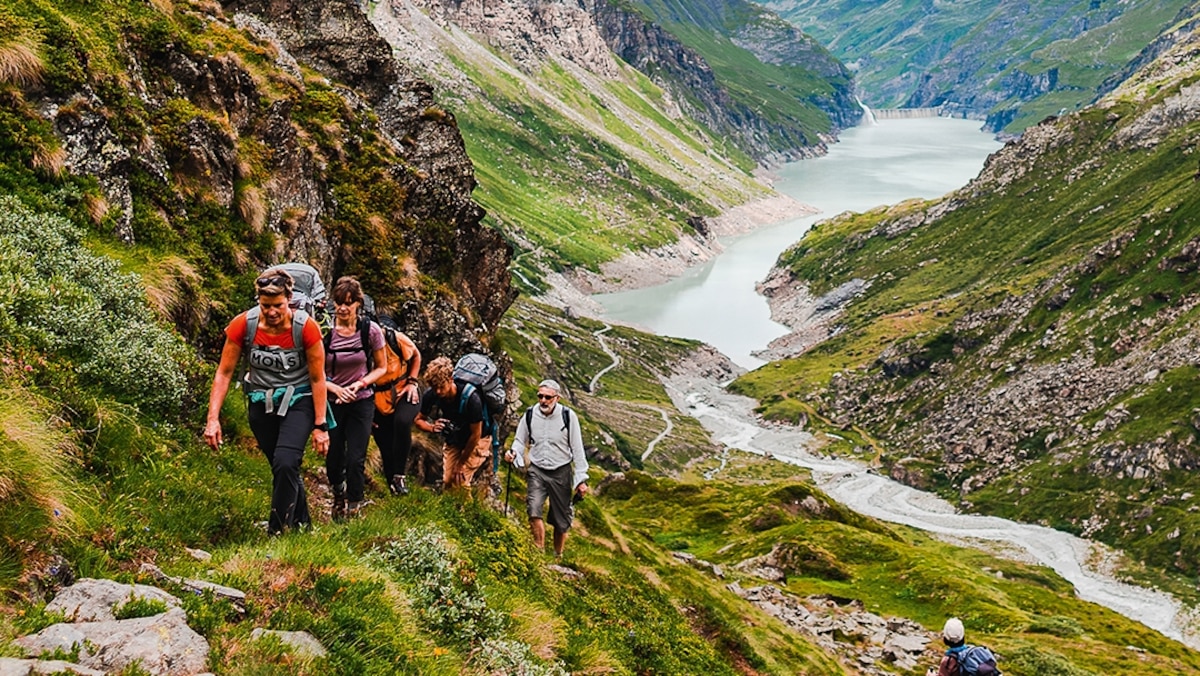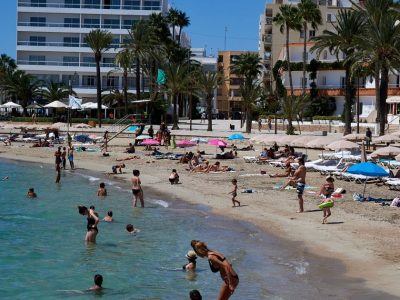This article was produced by National Geographic Traveller (UK).
“We’ll never be as popular as the Tour du Mont Blanc, and we’d never expect to be,” says mountain instructor Melanie Müri, as steaming bowls of apple and celeriac soup are passed down the long, wooden table. “But there’s so much untapped potential in this landscape.” We’re in the dining room of Cabane de Chanrion, a mountain hut set at an altitude of 8,077 feet below snow-speckled summits and razor-edge arêtes, narrow rock ridges that separate valleys with fang-like pinnacles. The hut’s stripped-back, pale-wood interior makes showpieces of the oversized windows, beyond which butterflies dance among the blue gentian flowers and marmots whistle. It’s a scene of playfulness and stark stillness, all in one.
Melanie has cut to the heart of an uneasy conundrum. I’m on day three of a six-day loop from the small Swiss village of Bourg-St-Pierre following the Tour des Combins, a 63-mile trail circumnavigating the little-known Grand Combin massif — a glaciated mountain range in southwest Switzerland’s Valais canton, straddling the border with Italy. Like Melanie, many locals in this corner of the Alps are torn: they covet recognition yet fear its consequences. They want to share this region’s treasures but also cherish its quietness. It’s a contradiction as sharp as the towering peaks outside.
Some critics argue such balance has eluded Mont Blanc — which, at 4,800 metres, is western Europe’s highest peak — none more so than Jean-Marc Peillex, mayor of Saint-Gervais, a village nestled at its foot. He made local headlines last summer after threatening to sue two hurluberlus (fools) who slept at the summit, flouting a law that prohibits camping throughout the 7,800-acre Mont Blanc natural protection zone. It was set up in 2020 with the aim of safeguarding the local environment by regulating activities in the face of a visitor swell.
The challenge of reining back tourism on the ‘roof of Europe’, as Mont Blanc is known, might be tougher than its ascent: some 20,000 climbers bid for the summit each year, and tens of thousands more set foot on the Tour du Mont Blanc (TMB).
A 105-mile, cross-country loop around the peak, the TMB is often cited as one of the world’s best mountain trails, as well as an Alpine rite of passage. But it was a different sort of baptism I’d experienced when starting the Tour des Combins. On the first day, a storm drenched the rolling pastures as I set off in blissful solitude. It was a game of cat and mouse between hiker and weather: when the thunder rumbled, I dove for cover inside an abandoned shepherd’s shelter; when the dark clouds subsided, I got my miles in quickly before the next downpour.
At the end of the 12-mile stage, with 4,100 feet of ascent in the bag, I sat back in the wood-panelled dining room of Cabane Brunet, dipping boiled potatoes into melted cheese. It had been a stuttering start, but I felt refreshed in more ways than one.

The accommodation in this part of the Alps, Cabane de Chanrion serves as a stark contrast to the landscapes outside. Photograph by Raphael Surmont
Coming full circle
The next morning, I set off from Cabane de Chanrion with Eloi Rossier, the grey-haired, long-standing president of the Association du Tour des Combins, hiking over steep, rock-strewn terrain to the 2,797-metre Fenêtre de Durand. This pass threads the eye of the needle between the sweeping ridges of Mont Gelé and Mont Avril — every twist, every turn, every stride unveiling new views. As I top out onto its rocky saddle in glorious midday sunshine, the 4,314-metre Grand Combin de Grafeneire is on the horizon, seemingly congratulating my lung-busting, calf-burning efforts.
The snowy summit of this Alpine leviathan is a constant presence on the Tour des Combins. “It’s higher and more Alpine, and you get high-quality but simple hospitality,” says Eloi when I ask how this trek compares to the TMB. “But we’re not in competition. We can be complementary, and, of course, people can walk both tours if they desire.”
Eloi may sound modest, but there are big plans in store for the Tour des Combins, which celebrated its 50th anniversary in 2023. A longer version — the 80-mile, eight-day Grand Tour des Combins — could be ready for its first hikers as early as next year. It will take in a night at Rifugio Frassati, which was built by volunteers in Italy’s Aosta Valley, and a hike past the trio of Alpine tarns at Lacs de Fenêtre, a Swiss lake.
Meanwhile, a promotional push is underway for the original route. It has much going for it: the length is perfect for a week-long trip, and there are convenient public transport links to Geneva. Although steep, the terrain is more than achievable for any competent hillwalker, and the route itself has all the ingredients to make it a bona fide trekking classic — suspension bridges above glaciers, Tolkien-like moonscapes and water bodies, flowing and frozen. Once word gets out, stemming the flow of visitors may prove trickier than selling the dream. “We want more visitors,” Eloi says, “but not too many. Definitely not too many.”

After celebrating its 50th anniversary last year, Tour des Combins is being extended to a longer, 80-mile version as early as next year. Photograph by Raphael Surmont
For the time being, I’m alone on the trails, and by now, I’ve settled into a routine. Each day, I climb up brutally steep saddles: I spot a horned ibex silhouetted atop a ridgeline; wispy clouds embracing the tops of giants; and icy-blue meltwater gushing from a glacier outflow. Each night, I share tales and mountain grub with fellow hikers met in yet another Alpine hut, each with a location as picturesque as the last.
A particular highlight is Hospice du Grand-Saint-Bernard, which I visit the following day. This historic refuge is best-known for accommodating Napoleon Bonaparte’s 40,000-strong army in 1800 — a visit that saw the kitchen serve up an incredible 21,724 bottles of wine and some 3,498lbs of cheese.
I feel I could consume a similar amount of food the next day, on the last leg of the trek. After a rocky descent of the Pas des Chevaux, a narrow old mule path weaving over craggy ground and fields of boulders, I loop back to Bourg-St-Pierre. “La boucle est bouclée,” says Sophie Dorsaz, one of my mountain instructors for the trip.
“The circle is complete.” As I look back at my time on the trail, the days as hazy as the dawn horizon, I reflect on another journey — that of the Alpine destinations that were hungry for attention, then bent under the influx of visitors and now want to find a sweet spot. It seems I’m not the only one to have come full circle.
Fly direct from the UK to Geneva with Swiss in around 1h45m, then transfer to Bourg-St-Pierre by train and bus in around 3h30m.
A seven-day guided trek with Horizons Nature costs from CHF 1,480 (£1,314) per person, including half-board accommodation in mountain huts, picnic lunches and most luggage transfers.
This story was created with the support of Verbier Tourism and Pays du St-Bernard Tourism
To subscribe to National Geographic Traveller (UK) magazine click here. (Available in select countries only).










